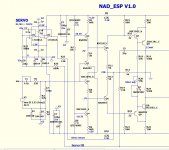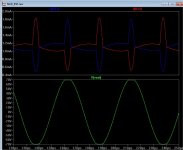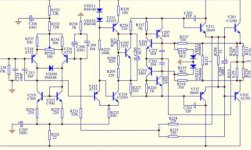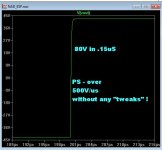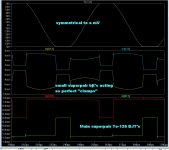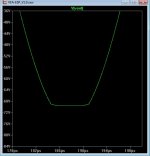OK I got to the bottom of my problem. The Arduino I bought is called a DCCduino. Evidently it has a CH340 USB-to-serial chip. I had to DL a special driver to get it to work. Fortunately it is now working. Now all I have to do is learn how to use it. 😉
OK I got to the bottom of my problem. The Arduino I bought is called a DCCduino. Evidently it has a CH340 USB-to-serial chip. I had to DL a special driver to get it to work. Fortunately it is now working. Now all I have to do is learn how to use it. 😉
Aaaahhh! Cool

BTW, you can use the LEDs with 1K resistors in series instead of the big relays for initial testing, just to see everything goes right - it's easy to see them switching on one by one as soft-start is performed...
Also, for better understanding of the plugs' polarity on the board. You can see a sort of a "key" on one side of each 2-pin plug. This plug always indicates the "bottom" pin, as shown on schematic. The other pin is the "top" one.
Sorry, I meant "This key always indicates..."
I'm back!
No Internet (wired) here 😡 .
Took a month to research 3G/Evdo wireless (expensive B$ ISP's).
Have 2 new IPS's.
VFA/superpair version
AND a CFA/superpair with 1K/V us.
Both self clamp on saturation.
Glad to see this thread did not fall into oblivion. 🙂
🙂
?? Lateral OPS ? any boards ?
OS
No Internet (wired) here 😡 .
Took a month to research 3G/Evdo wireless (expensive B$ ISP's).
Have 2 new IPS's.
VFA/superpair version
AND a CFA/superpair with 1K/V us.
Both self clamp on saturation.
Glad to see this thread did not fall into oblivion.
 🙂
🙂?? Lateral OPS ? any boards ?
OS
No Internet (wired) here 😡 .
Took a month to research 3G/Evdo wireless (expensive B$ ISP's).
Have 2 new IPS's.
VFA/superpair version
AND a CFA/superpair with 1K/V us.
Both self clamp on saturation.
Glad to see this thread did not fall into oblivion.🙂
?? Lateral OPS ? any boards ?
OS
We have been waiting for the new IPS. Looking forward to seeing them.
Jason designed a couple layouts for the Lateral IPS. I've been waiting to see if he was going order some. If not I will. I'd be happy to send you a pair if I'm the one who orders them.
I etched the first layout and they actually work very well with the CFA-XH and the Wolverine.
Blessings, Terry
Ostripper,
It's great to see that you are back! I'm looking forward to seeing your latest handiwork.
It's great to see that you are back! I'm looking forward to seeing your latest handiwork.
We have been waiting for the new IPS. Looking forward to seeing them.
Jason designed a couple layouts for the Lateral IPS. I've been waiting to see if he was going order some. If not I will. I'd be happy to send you a pair if I'm the one who orders them.
I etched the first layout and they actually work very well with the CFA-XH and the Wolverine.
Blessings, Terry
Once Spooky is ready I will get some of the Mini OPS at the same time.
I'm looking forward to the latest too

Only 2 IPS's ... but they rock !
The VFA (attachment 1) is the original luxman IPS + a super-pair VAS.
- 10ppm THD20
-soft clipping
- faster slew than the typical VFA.
The CFA (attachment 2) is a re-do of the NAD-CFA.
The super-pair not only alleviates the stress on the current FB stage,but
has faster slew ,easier current trim , and the same "self-clamping" clip
behavior (attachment 3).
Both are literally saturation proof ( superpair to-92's shut off .. att 3 - upper plot) ... with
"tubelike" clip harmonics.
.... Less load on either VFA or CFA input stages .... superpairs are like
the blameless beta enhanced VAS , but with superior speed,slew and
overload characteristics. 😎
I now see why this is the Yamaha "way". Apex on the forum has also
used the superpair.
PS - on this forum (I might be wrong) ... this is the first "symmetric
super-pair"
OS
The VFA (attachment 1) is the original luxman IPS + a super-pair VAS.
- 10ppm THD20
-soft clipping
- faster slew than the typical VFA.
The CFA (attachment 2) is a re-do of the NAD-CFA.
The super-pair not only alleviates the stress on the current FB stage,but
has faster slew ,easier current trim , and the same "self-clamping" clip
behavior (attachment 3).
Both are literally saturation proof ( superpair to-92's shut off .. att 3 - upper plot) ... with
"tubelike" clip harmonics.
.... Less load on either VFA or CFA input stages .... superpairs are like
the blameless beta enhanced VAS , but with superior speed,slew and
overload characteristics. 😎
I now see why this is the Yamaha "way". Apex on the forum has also
used the superpair.
PS - on this forum (I might be wrong) ... this is the first "symmetric
super-pair"
OS
Attachments
Sweet. Any concerns about the super pair and internal stability? Some info I've read suggests they can be finicky.
Sweet. Any concerns about the super pair and internal stability? Some info I've read suggests they can be finicky.
I read that too !!
The Koda KD261 has a "cult following" (they mod this amp like a hotrod).
It also has a bad habit of instability (attachment 1).
The Yamaha XP series , on the other hand , has the best record for reliability.
😕
Superpairs are actually a very tight FB loop. The probe shows the pole is
near the Ft of the BJT's.
Beta is close to the wolverine/badger ... only a few uA to "swing" the VAS.
Look at the 2'nd attachment .... slew is 500V/uS with no tweaks.
Superpairs are much faster than the hawksford/single BJT.
PS - I was also both apprehensive and surprised by the superpair's performance.
I could only imagine the slew of a CFA-X/super-pair combo ... overkill ??
😀😀 ... (2kV+ ?)
OS
Attachments
Well, I say we hit that. I'd love to offer some new 'next level' designs to mate up to an OPS.
I have also been playing with a multi-pair EF buffered BIGBT output stage in spice. Might not really fit with the thread but looks interesting so far.
I have also been playing with a multi-pair EF buffered BIGBT output stage in spice. Might not really fit with the thread but looks interesting so far.
Well, I say we hit that. I'd love to offer some new 'next level' designs to mate up to an OPS.
I have also been playing with a multi-pair EF buffered BIGBT output stage in spice. Might not really fit with the thread but looks interesting so far.
😎
Can you share your schematic for multi-pair EF buffered BIGBT output stage?
OS, welcome back.
I have so many question to you but right now I will ask one question only 😀.
Why did you discontinue about GLA IPS and change it to Symasui IPS? I sim GLA IPS, it have very low THD.
I have so many question to you but right now I will ask one question only 😀.
Why did you discontinue about GLA IPS and change it to Symasui IPS? I sim GLA IPS, it have very low THD.
OS, welcome back.
I have so many question to you but right now I will ask one question only 😀.
Why did you discontinue about GLA IPS and change it to Symasui IPS? I sim GLA IPS, it have very low THD.
The GLA is just a differential feeding a second differential (with a level shifting
I to V stage after).
The symasui is also just two differentials .... the difference being that the 2'nd
one also doubles as the I to V stage , as well.
In short , the Symasui performs just as good as the GLA without the extra
stability issues or complexity.
Loop gain and THD are nearly identical between the 2 variants.
I'm excited about both being online , still having 2 of my 4 PC's working
(pod storage was 80C and fried much of my electronics 😡😡).
A most frustrating and expensive relocation.... glad it is OVER !!
I am going to try a superpair "spooky" next ... maybe even a superpair/ hawksford "abomination" ... "hyper-VAS".
This will kill both the early effect AND device saturation.
I predict 1ppm THD20 , perfect clip , and almost CFA slew
for a spooky-superpair (superspook 😀 )
PS - my "prediction" is objectively based .... any previous design gets a 3-6db
CL gain boost , less loading , and a drastic clip/slew improvement over the hawksford
based designs. NO change in transient/stability tests.
OS
Last edited:
Why I am on the "superpair "kick" ...
Observe (attachment 1).
top plot is a perfect symmetrical overload.
Middle plot shows the low current superpair "clamping" the main
VAS bjt's .... (bottom plot).
The 3 Yamaha amps (schema's)... like this use no heatsink in the IPS ... ,
this is because all the stages actually dissipate LESS during
overload.
-The "blameless" overloads and draws more current from both
the beta enhancement device ( and both CCS's) .
-The Hawksford VAS's will also demand more current from the
preceding stage . This was (IS) an issue with most of the CFA
designs.
- We WILL clip our amps (even occasionally) .. the behavior at
this point will be heard (or we will smell it 😀 ).
Superpairs have classic "rounded" tops when over-driven (tube-like??)
- (attachment 2) ...
Hope this explains the improvements ... both in reliability and performance.
OS
Observe (attachment 1).
top plot is a perfect symmetrical overload.
Middle plot shows the low current superpair "clamping" the main
VAS bjt's .... (bottom plot).
The 3 Yamaha amps (schema's)... like this use no heatsink in the IPS ... ,
this is because all the stages actually dissipate LESS during
overload.
-The "blameless" overloads and draws more current from both
the beta enhancement device ( and both CCS's) .
-The Hawksford VAS's will also demand more current from the
preceding stage . This was (IS) an issue with most of the CFA
designs.
- We WILL clip our amps (even occasionally) .. the behavior at
this point will be heard (or we will smell it 😀 ).
Superpairs have classic "rounded" tops when over-driven (tube-like??)
- (attachment 2) ...
Hope this explains the improvements ... both in reliability and performance.
OS
Attachments
Hi OS! Great to see you back 😉
Just woke up on this side of the Earth... and so many things have happened 😛
I like your recearch on super-pair. Rounded tops clipping looks very cool.
Cheers,
Valery
Just woke up on this side of the Earth... and so many things have happened 😛
I like your recearch on super-pair. Rounded tops clipping looks very cool.
Cheers,
Valery
Hi OS! Great to see you back 😉
Just woke up on this side of the Earth... and so many things have happened 😛
I like your recearch on super-pair. Rounded tops clipping looks very cool.
Cheers,
Valery
Almost want to go to sleep on my side of the earth and wake up
on your side.... 😱
Just found out all I can do on Sprint PCS is surf google , buy things
from amazon/ebay ... or zone out on youtube !
ALL else is either censored of in violation of contract (bad sites , P2P).
WOW ! 🙁
Can't even get a new Linux ISO ! (legal)
The corporate masters still allow me to post on DIYA (for now).
OS
The VFA (attachment 1) is the original luxman IPS + a super-pair VAS.
- 10ppm THD20
-soft clipping
- faster slew than the typical VFA.
The CFA (attachment 2) is a re-do of the NAD-CFA.
The super-pair not only alleviates the stress on the current FB stage,but
has faster slew ,easier current trim , and the same "self-clamping" clip
behavior (attachment 3).
Both are literally saturation proof ( superpair to-92's shut off .. att 3 - upper plot) ... with
"tubelike" clip harmonics.
.... Less load on either VFA or CFA input stages .... superpairs are like
the blameless beta enhanced VAS , but with superior speed,slew and
overload characteristics. 😎
I now see why this is the Yamaha "way". Apex on the forum has also
used the superpair.
PS - on this forum (I might be wrong) ... this is the first "symmetric
super-pair"
OS
It is not first symmetric super (baxandall) pair on this forum, look the GainWire mk2 or some of my power CFA as this one http://www.diyaudio.com/forums/solid-state/243481-200w-mosfet-cfa-amp-51.html#post3999756.
- Home
- Amplifiers
- Solid State
- Slewmaster - CFA vs. VFA "Rumble"

